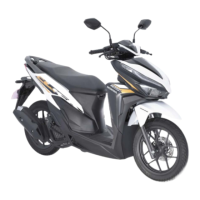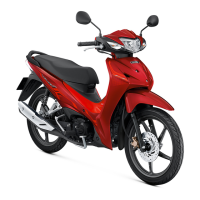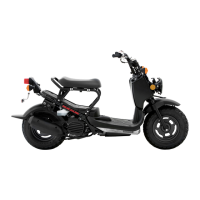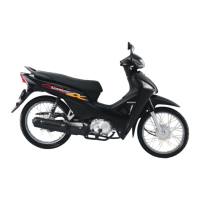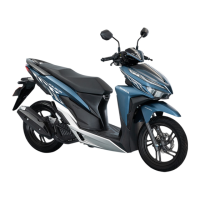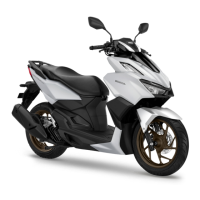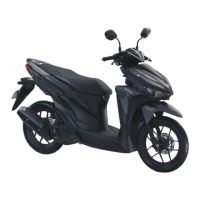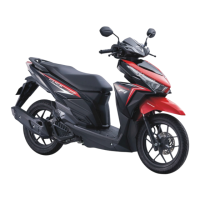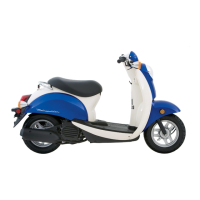Do you have a question about the Honda CLICK125i 2018 and is the answer not in the manual?
Wear helmets and protective apparel to significantly reduce head and other injury severity.
Ensure physical/mental fitness and absence of alcohol/drugs before riding.
Familiarize with scooter handling and controls in a safe area.
Be aware of other vehicles and prepared to react to traffic changes.
Wear approved helmet, eye protection, and high-visibility clothing.
Ensure helmet is certified, high-visibility, and fits securely with strap fastened.
Use full-finger leather gloves with high abrasion resistance for hand protection.
Wear sturdy boots with non-slip soles and ankle protection.
Wear protective, visible, long-sleeved jacket and durable trousers.
Follow initial 500 km guidelines for scooter reliability and performance.
Observe braking guidelines: caution on low traction surfaces and proper brake operation.
Verify all display modes and segments function when ignition is turned on.
Shows the scooter's speed in kilometers per hour (km/h).
Displays instant fuel mileage; shows '0' if speed is below 3 km/h.
Indicates remaining fuel; first segment flashes when ~1.2 litres remain.
Displays time in a 12-hour format. See P.21 to set the clock.
Displays total distance, trip distance, average fuel mileage, and battery voltage.
Details total distance (Odometer) and distance since reset (Tripmeter A/B).
Calculates average fuel mileage based on Tripmeter A.
Displays the current battery voltage.
Notifies when programmed oil change interval is reached. Reset after oil change.
Allows sequential changing of clock and oil change indicator settings.
Step-by-step guide to set the hour and minute digits for the clock.
Indicates when the high beam is active.
Indicates left and right turn signals are active.
Lights up if there's a problem with the PGM-FI system.
Comes on if the engine coolant temperature becomes too high.
Indicates when the Idling Stop system is active or ready.
Controls the Idling Stop system, turning it ON or OFF.
Controls the headlight, taillight, and position lights.
Used to start the engine.
Pressing this switch opens the seat.
Activates and deactivates the turn signals.
Activates the horn.
Selects between high beam and low beam for the headlight.
Controls electrical system, steering lock, and seat opener.
Secures the steering to prevent theft when parked.
Uses the Idling Stop switch to enable or disable the system.
Details requirements for the system to become ready to stop the engine.
Procedure for starting the engine using the electric start button.
Procedure for starting the engine using the kickstarter.
Steps to push off the stand, get on, release brake lock, and start moving.
How to control speed by opening or closing the throttle.
Instructions on how to open the fuel tank cap.
Instructions on how to securely close the fuel fill cap.
Step-by-step guide to open and close the seat compartment.
Details the tools provided for roadside repairs and adjustments.
Information on the luggage box capacity and weight limit.
Describes the hook provided below the handlebar for carrying light luggage.
Describes the glove box provided below the handlebar and its load limit.
Guidelines for performing maintenance safely and responsibly.
Procedure to check key items before riding the scooter for safety.
Check operation, fluid level, pads wear, and rear lever freeplay.
Check function of lights, indicators, and horn.
Check for proper function of the side stand safety feature.
Check condition, air pressure, and adjust as necessary.
Information on the maintenance-free battery, cleaning terminals, and disposal.
Explains fuses, inspection, and replacement procedures.
Do not replace brake fluid except in emergencies; use fresh fluid.
Use genuine Honda PRE-MIX COOLANT; inspect and replace per schedule.
Service frequently if riding in rain, at full throttle, or after overturning.
Check air pressure, inspect for damage, abnormal wear, and tread depth.
Use recommended tyres; do not install tubes in tubeless tyres.
Scooter has a viscous element; do not perform maintenance, service by dealer.
Step-by-step guide for removing and installing the battery.
Check oil level with Idling Stop switch at IDLING; ensure level is between marks.
Add recommended oil if level is low; do not overfill.
Procedure for changing engine oil and cleaning the oil strainer screen.
Check coolant level in the reserve tank while engine is cold.
Add recommended coolant if level is below LOWER mark; do not overfill.
Check fluid level in reservoir; inspect pads for wear if level is low.
Check wear indicators; replace pads if worn to the indicator.
Measure distance lever moves before brake holds; check cable condition.
Turn adjusting nut to set freeplay; check wheel rotation after adjustment.
Check wear indicator arrow; replace shoes if arrow aligns with reference mark.
Check smooth operation, lubricate pivot; ensure engine stops when stand is lowered.
Check smooth rotation, freeplay, and cable condition.
Adjust vertical aim of the headlight using the pinion.
Check starting sequence, fuel, PGM-FI lamp.
Check starting sequence, fuses, battery connection/condition.
Lights up if there's a serious problem with the PGM-FI system.
Displays fuel gauge errors if the fuel system has an issue.
Troubleshoot why the Idling Stop indicator is not displayed.
Troubleshoot why the engine doesn't stop when the indicator is on.
Troubleshoot why the engine won't start after being stopped by the system.
Guide for making an emergency repair using a tubeless tyre repair kit.
Instructions for charging a dead battery using a motorcycle charger.
Check LED lights with dealer if they are not turned on.
Procedure for checking and replacing blown fuses.
Record key number, store spare key safely, and contact dealer for duplicates.
Do not leave in ON position with engine stopped; do not turn while riding.
Displays total distance ridden; locks at 999,999.
Resets to 0.0 after 999.9; also resets average fuel mileage.
Stores owner's manual, registration, and insurance info.
Rinse with low-pressure hose, use mild cleaner, rinse again, and dry.
Avoid high-pressure washers, direct water at muffler, under seat, or air cleaner.
Clean regularly, avoid stiff brushes and abrasives.
Wash gently, use diluted detergent for stains, avoid chemicals on instruments.
Lists key specifications like overall dimensions, weight, and engine displacement.
Provides technical data for tyres, spark plugs, fluids, and capacities.
Wear helmets and protective apparel to significantly reduce head and other injury severity.
Ensure physical/mental fitness and absence of alcohol/drugs before riding.
Familiarize with scooter handling and controls in a safe area.
Be aware of other vehicles and prepared to react to traffic changes.
Wear approved helmet, eye protection, and high-visibility clothing.
Ensure helmet is certified, high-visibility, and fits securely with strap fastened.
Use full-finger leather gloves with high abrasion resistance for hand protection.
Wear sturdy boots with non-slip soles and ankle protection.
Wear protective, visible, long-sleeved jacket and durable trousers.
Follow initial 500 km guidelines for scooter reliability and performance.
Observe braking guidelines: caution on low traction surfaces and proper brake operation.
Verify all display modes and segments function when ignition is turned on.
Shows the scooter's speed in kilometers per hour (km/h).
Displays instant fuel mileage; shows '0' if speed is below 3 km/h.
Indicates remaining fuel; first segment flashes when ~1.2 litres remain.
Displays time in a 12-hour format. See P.21 to set the clock.
Displays total distance, trip distance, average fuel mileage, and battery voltage.
Details total distance (Odometer) and distance since reset (Tripmeter A/B).
Calculates average fuel mileage based on Tripmeter A.
Displays the current battery voltage.
Notifies when programmed oil change interval is reached. Reset after oil change.
Allows sequential changing of clock and oil change indicator settings.
Step-by-step guide to set the hour and minute digits for the clock.
Indicates when the high beam is active.
Indicates left and right turn signals are active.
Lights up if there's a problem with the PGM-FI system.
Comes on if the engine coolant temperature becomes too high.
Indicates when the Idling Stop system is active or ready.
Controls the Idling Stop system, turning it ON or OFF.
Controls the headlight, taillight, and position lights.
Used to start the engine.
Pressing this switch opens the seat.
Activates and deactivates the turn signals.
Activates the horn.
Selects between high beam and low beam for the headlight.
Controls electrical system, steering lock, and seat opener.
Secures the steering to prevent theft when parked.
Uses the Idling Stop switch to enable or disable the system.
Details requirements for the system to become ready to stop the engine.
Procedure for starting the engine using the electric start button.
Procedure for starting the engine using the kickstarter.
Steps to push off the stand, get on, release brake lock, and start moving.
How to control speed by opening or closing the throttle.
Instructions on how to open the fuel tank cap.
Instructions on how to securely close the fuel fill cap.
Step-by-step guide to open and close the seat compartment.
Details the tools provided for roadside repairs and adjustments.
Information on the luggage box capacity and weight limit.
Describes the hook provided below the handlebar for carrying light luggage.
Describes the glove box provided below the handlebar and its load limit.
Guidelines for performing maintenance safely and responsibly.
Procedure to check key items before riding the scooter for safety.
Check operation, fluid level, pads wear, and rear lever freeplay.
Check function of lights, indicators, and horn.
Check for proper function of the side stand safety feature.
Check condition, air pressure, and adjust as necessary.
Information on the maintenance-free battery, cleaning terminals, and disposal.
Explains fuses, inspection, and replacement procedures.
Do not replace brake fluid except in emergencies; use fresh fluid.
Use genuine Honda PRE-MIX COOLANT; inspect and replace per schedule.
Service frequently if riding in rain, at full throttle, or after overturning.
Check air pressure, inspect for damage, abnormal wear, and tread depth.
Use recommended tyres; do not install tubes in tubeless tyres.
Scooter has a viscous element; do not perform maintenance, service by dealer.
Step-by-step guide for removing and installing the battery.
Check oil level with Idling Stop switch at IDLING; ensure level is between marks.
Add recommended oil if level is low; do not overfill.
Procedure for changing engine oil and cleaning the oil strainer screen.
Check coolant level in the reserve tank while engine is cold.
Add recommended coolant if level is below LOWER mark; do not overfill.
Check fluid level in reservoir; inspect pads for wear if level is low.
Check wear indicators; replace pads if worn to the indicator.
Measure distance lever moves before brake holds; check cable condition.
Turn adjusting nut to set freeplay; check wheel rotation after adjustment.
Check wear indicator arrow; replace shoes if arrow aligns with reference mark.
Check smooth operation, lubricate pivot; ensure engine stops when stand is lowered.
Check smooth rotation, freeplay, and cable condition.
Adjust vertical aim of the headlight using the pinion.
Check starting sequence, fuel, PGM-FI lamp.
Check starting sequence, fuses, battery connection/condition.
Lights up if there's a serious problem with the PGM-FI system.
Displays fuel gauge errors if the fuel system has an issue.
Troubleshoot why the Idling Stop indicator is not displayed.
Troubleshoot why the engine doesn't stop when the indicator is on.
Troubleshoot why the engine won't start after being stopped by the system.
Guide for making an emergency repair using a tubeless tyre repair kit.
Instructions for charging a dead battery using a motorcycle charger.
Check LED lights with dealer if they are not turned on.
Procedure for checking and replacing blown fuses.
Record key number, store spare key safely, and contact dealer for duplicates.
Do not leave in ON position with engine stopped; do not turn while riding.
Displays total distance ridden; locks at 999,999.
Resets to 0.0 after 999.9; also resets average fuel mileage.
Stores owner's manual, registration, and insurance info.
Rinse with low-pressure hose, use mild cleaner, rinse again, and dry.
Avoid high-pressure washers, direct water at muffler, under seat, or air cleaner.
Clean regularly, avoid stiff brushes and abrasives.
Wash gently, use diluted detergent for stains, avoid chemicals on instruments.
Lists key specifications like overall dimensions, weight, and engine displacement.
Provides technical data for tyres, spark plugs, fluids, and capacities.
